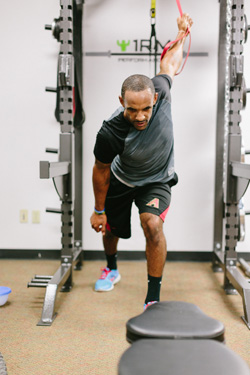1+1 = Speed!
The fastest sprinters have an optimal stride length, stride frequency, and very short contact time with the ground. What if I told you that you can take steps to becoming a faster sprinter just by jumping? No, that’s not a typo… I said jumping. That may seem absurd, but it’s true. You could perform a 4-week plyometric program and become faster without running a single suicide, as long as the program is designed properly. It must include:
1.) Single leg jumps
2.) Broad jumps
Let me give you a slight glimpse of the magic behind our secret. Broad jumps and single leg jumps. Take the emphasis off vertical jumps. By doing this, you will increase your muscular power. I want you to visualize the fastest person you know. Imagine how quick their feet make contact with the ground, how long their strides are, how frequent their strides are, and how long their flight time is. All of these things depend on muscular power; and that is exactly what you train through broad jumps and single leg jumps. There are other types of jumps that will also train muscular power, but broad jumps and single leg jumps are most highly correlated with sprint speed.
Why is that? Well first of all, almost all movement in sport is performed on a single leg. Look at Tyson Gay, and Usain Bolt above - these two are undoubtably the fastest men of all time. Notice how both are literally hovering over the ground, neither man is jumping into the air, but rather, each is propelling themselves forward on a single leg! You don’t see athletes hopping around like flamingos, but every step taken, every shuffle, and every lay-up starts with one foot. If you look at someone running, only one foot is in contact with the ground (that is the difference between running and walking). And why broad jumps (or horizontal jumps)? Because they are similar to the drive phase of sprinting. When you sprint, the goal is to accelerate forward as quickly as possible, not upwards.
We will talk about this more later, but remember, you are training for maximal power. That doesn’t mean you should go perform broad jumps across the entire football field. And we definitely don’t want you doing skaters (single leg lateral jumps) for 2 minutes. Maximal effort means very short sets with high intensities followed by rest. For example, if you actually did broad jumps across the football field, I can guarantee you wouldn’t be jumping much further than 3 feet each jump at the end. To put it bluntly, that is a lame jump. And if you train to jump lame distances, than you are going to perform the same way during competition. Allow for recovery, and train for max distance. Enough said.
To catch a glimpse of some plyos that we use with our athletes to deveop single leg power check out the video...
- Baker, D., and Nance, S. (1999). The relation between running speed and measures of strength and power in professional rugby league players. Journal of Strength and Conditioning Research 13(3), 230-235.
- Cronin, J., and Hansen, K. (2005). Strength and power predictors of sports speed. Journal of Strength and Conditioning Research 19(2) 349-357.
- Faigenbaum, A. (2005). Plyometrics for kids: facts and fallacies. Journal of Strength and Conditioning Research 5(2) 13-16.
- Faigenbaum, A., Kramer, W., Blimkie, C., Jeffreys, I., Micheli, J., Nitka, M., and Roland, T. (2009). Youth resistance training: updated position statement paper from the National Strength and Conditioning Association. Journal of Strength and Conditioning Research 23(5) 60-79.
- Faigenbaum, A., McFarland, J., Keiper, F., Tevlin, W., Ratamess, N., Kang, J., and Joffman, J. (2007). Effects of a short-term plyometric and resistance training program on fitness performance in boys age 12 to 15 years. Journal of Sports Science and Medicine (6) 519-525.
- Holm, D., Stalbom, M., Keogh, J., and Cronin, J. (2008). Relationship between the kinetics and kinematics of a unilateral horizontal drop jump to sprint performance. Journal of Strength and Conditioning Research 22(5) 1589-1596.
- Kale, M., Asci, A., Bayrak, C., and Acikada, C. (2009). Relationships among jumping performances and sprint parameters during maximum speed phase in sprinters. The Journal of Strength and Conditioning Research 23(8) 2272-2279.
- McBride, J., Triplett-Mcbride, T., Davie, A., and Newton, R. (2002). The effect of heavy- vs. light-load jump squat on the development of strength, power and speed. The Journal of Strength and Conditioning Researh 16(1): 75-82.
- McCurdy, K., Walker, J., Langford, G., Kutz, M., Guerrero, J., and McMillan, J. (2010). The relationship between kinematic determinants of jump and sprint performance in Division I women soccer players. The Journal of Strength and Conditioning Research 24(12) 3200-3208.
- Meylan, C., McMaster, T., Cronin, J., Mohammad, N., Rogers, C., and DeKlerk, M. (2009). Single-leg lateral, horizontal and vertical jump assessment: reliability, interrelationships, and ability to predict sprint and change-of-direction performance. The Journal of Strength and Conditioning Research 23(4): 1140-1147.
- Morin, JB and Belli, A. (2003). Mechanical factors of 100 m sprint performance in trained athletes. Sci Sports 18: 161-163.
- Tricoli, V., Lamas, L., Carnevale, R., and Ugrinowitsch, C. (2005). Short-term effects on lower-body functional power development: weightlifting vs. vertical jump training programs. Journal of Strength and Conditioning Research 19(2) 433-437.
- Yetter, M. and Moir, G. (2008). The acute effects of heavy back and front squats on speed during forty-meter sprint trials. Journal of Strength and Conditioning Research 22(1) 159-165.

